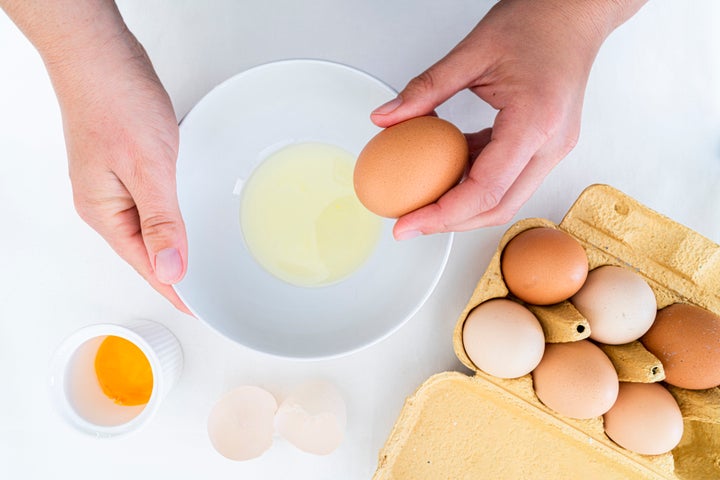
It’s hard to believe what people can find to argue about these days, but one big kerfuffle in the culinary world is about how to crack an egg. Some home cooks say hitting the shell on a flat surface, like a counter, is less likely to rupture the yolk, but others argue that the edge of a bowl produces a stronger break. And then there are those who suggest using a knife, or cracking an egg against another egg.
Who knew there were so many ways to complete this simple cooking task? Well, chefs, of course — and they shared their opinions with us. When you consider how many eggs a home cook cracks in a day, compared to how many a chef might crack, it’s probably wise to follow the advice of these professionals.
As Bjorn Thompson, executive chef at Breva at Hotel Ivy in Minneapolis, said: “After cracking a few thousand eggs, I developed a preference for how to streamline the process.” So with that, let’s crack on.
Which method do most chefs prefer, and why?
The chefs we talked to said that how you crack an egg does make a difference in your cooking. You want to keep as much of the shell intact as possible, so you don’t end up with fragments in your finished dish. You also want to keep the yolk intact ― especially when you’re poaching or frying eggs, or making something where the whites and yolks need to be separated. Because it’s more likely to protect the yolk, most chefs we talked to prefer cracking the shell flat against a countertop, rather than on the edge of a bowl.
Penny Stankiewicz, chef-instructor at the Institute of Culinary Education, explained the food-safety case for countertop cracking: “Eggs are not clean on the outside, and cracking one on the rim of a bowl can force shell inside, and could end up contaminating the inside of the egg with the shell’s bacteria.”
Culinary scientist, food scientist and author Jessica Gavin said the countertop method avoids damaging the egg’s vitelline membrane, which protects the yolk. “If you crack on the edge of a bowl, you need to control the force to avoid piercing the delicate yolk membrane,” she said.
The countertop is not only safer, but faster.
Other chefs who prefer the “flat surface” method include Bruno Enciso, chef de cuisine at Lutèce in Washington, D.C. For him, it’s a matter of speed, which is always a top priority in a professional kitchen. “I can crack many eggs at one time with this method, whereas on the edge of a bowl you have to crack each egg one at a time,” he said.
We heard a similar argument for efficiency from Marque Collins, director of food and beverage operations for Tullibee and the Hewing Hotel in Minneapolis. “Usually I’m cracking eggs in bulk for brunch, so the countertop method tends to make less mess and is pretty efficient when I’m going through flats of eggs at a time,” he said.

Other methods include using a knife — or even another egg.
Chef Tolu Eros of Ile in Los Angeles generally prefers the flat-surface approach, but noted that there are occasions that call for a specialised tool. “If you’re trying to separate the egg, you might use a sharper tool, like a knife, to make a cleaner break in the middle,” he said.
You don’t need a counter or a bowl if you follow Stankiewicz’s suggestion. “I prefer to crack eggs against one another,” she said. “Only one at a time ever cracks, and since I’m generally cracking many eggs at once, this method really moves things along.”
The site of the crack matters, too, said chef Shamim Popal, co-owner and chef of Lapis in Washington, D.C. “I always crack an egg in the middle, then raise it over the bowl and split it in two with my thumbs,” she said. “By cracking in the middle, you have two shells, and it’s easy to separate the white from the yolk if needed. You get a clean cut and avoid getting runny egg on your fingers or dropping bits of shell in the bowl.”
Once the egg is cracked, your work isn’t done. According to chef Yoonjung Oh of Hive Hospitality, “the main takeaway is to be vigilant about avoiding shell pieces, so always double-check after cracking to ensure a clean result.”
Give your cracked eggs a ‘layover’ in a separate bowl.
Most of us grew up just tossing raw eggs directly into a dish, but that approach carries some serious potential flaws, said Altreisha Foster, baker and owner of Sugar Spoon Desserts and president of the Cake Therapy Foundation.
“I prefer cracking eggs one at a time into a small bowl before adding them individually to my batter,” she said. “This gives me control over each egg and prevents any mishaps that could ruin the batter, like broken yolks, bad eggs, rotten eggs or pieces of falling shell. Cracking into a separate bowl is the best way to avoid any issues before mixing ingredients.”
Yes, your attitude matters, too.
No matter which method you choose, be aware that eggs sense fear, so proceed boldly.
OK, maybe that’s an exaggeration, but Eros did say that a little swagger can be a big asset. “The real trick is to crack with confidence and know how to handle the egg once it’s open,” he said. “Separating the shells smoothly makes a big difference, but the method you choose is more about personal preference.”